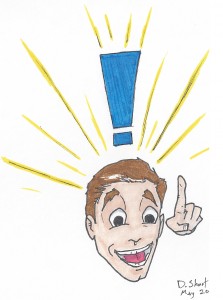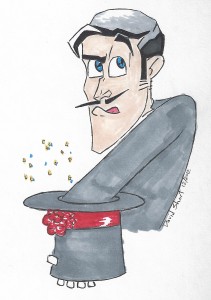
 From The Power of Habit: Why We Do What We Do in Life and Business by Charles Duhigg, we learn the science behind habits. Habits lead to lasting change. This book goes well with and overlaps just a little bit with Willpower: Rediscovering the Greatest Human Strength which I reviewed a few months back. I will cover it in a few posts because of the volume of great information contained in it.
From The Power of Habit: Why We Do What We Do in Life and Business by Charles Duhigg, we learn the science behind habits. Habits lead to lasting change. This book goes well with and overlaps just a little bit with Willpower: Rediscovering the Greatest Human Strength which I reviewed a few months back. I will cover it in a few posts because of the volume of great information contained in it.
Duhigg shares that habits are comprised of three components
The Cue is a trigger that tells our brain to go into automatic mode and that tells us which routine to follow. The Routine is the action that occurs and the Reward is the event which helps the brain figure out if this routine is worth remembering. As we go through this cycle, the routine gets reinforced within the basal ganglia in our brains.Soon our conscious mind can go deal with other matters and the routine gets played out without effort.
As a habit gets developed both the cue and the reward create a craving in the brain. Businesses use these cravings to its advantage. Toothpaste adds mint related ingredients, because we associate the tingling feeling with clean teeth.
A series of experiments was performed with Eugene, a man who (because of a viral infection that attacked his brain), could not remember anything more than a few minutes. Through repetition, he learned to pick the “correct” card when shown two cards. He could give no explanation of why he made the particular choice. In fact, he was not even aware that he had sat down choose between two cards many times before.
After discussing individual habits and their formation. Duhigg talks about habits in the organization. In this, probably the best section of the book, we learn about how Paul O’Neill transformed Alcoa. When O’Neill was chosen as CEO of Alcoa, he knew that Alcoa had plenty of problems and he had to change the culture. Many were dismayed when he first met with Wall Street investors, and told them that the Plan was to make Safety the highest priority. Many were dumbstruck, when he responded to questions about financial strategies by reiterating the evacuation plan for the building, and pointing out the emergency exits.
What O’Neill was doing by choosing Safety as his Mantra, was taking advantage of a Keystone Habit. A Keystone habit is one that positively affects other beneficial habits. By emphasizing Safety, O’Neill was doing several things. He was changing the way that management interacted with the laborers. He was making everyone focus on making the plants run more efficiently, because if they are efficient, they are less likely to cause injuries. If someone got hurt in an Alcoa plant, whole procedures kicked in to make sure that issues were resolved. This focus lead Alcoa to become very profitable, and successful. This Keystone habit played a critical role.
Durhigg shares how Keystone habits can help individuals.
- ” When people start habitually exercising, even as infrequently as once a week, they start changing other, unrelated patterns in their lives, often unknowingly. Typically people who exercised start eating better and being more productive at work. They smoke less and show more patience with colleagues and family. They use credit cards less frequently and say they feel less stressed. It’s not completely clear why. But for many people, exercise is a keystone habit that triggers widespread change”
I can vouch for the power of Keystone habits. For me, riding my bike to work is a keystone habit. When I do it, It causes me to try to eat healthier, to not drink sodas at work (even though they are free!) and I feel like I am more focused and productive.
- “Studies have documented that families who habitually eat dinner together seem to raise children with better homework skills, higher grades, greater emotional control, and more confidence. making your bed every morning is correlated with better productivity, a greater sense of well-being, and stronger skills at sticking with a budget. It’s not that a family meal or a tidy bed causes better grades or less frivolous spending. But somehow those initial shifts start chain reactions that help other good habits take hold.”
There is a lot of other good info in The Power of Habit, which I strongly recommend, and I will write more about in a future blog post.
In the Appendix, Duhigg provides a reader’s guide where he suggests affecting change by the following steps:
Maybe the routine is grabbing a sugary soda, or losing our temper when talking to a co-worker. We first need to identify the action that is the core of our habit. Particularly if it is one that we are trying to change. Experience has taught us that it is not easy to simply get rid of the action, but better to determine a substitute action. Maybe we need to substitute a few squeezes to a stress ball, instead of saying the words that we will regret.
We generally have habits, because they provide us with some reward. We need to see how our new routine provides us with a reward that is desirable enough to draw us to the new action. It might be the same reward associated with our old action. We should get creative here.
What is the event that causes our habit to kick in? This can be tricky. Our environment is very noisy and distracting so we need to keep a good record or diary to discover recurring patterns.
Once you understand your cue, routine and reward you can make a plan to remold your behavior. For example, let’s say that you want to stop playing solitaire when you have deadlines to meet. You realize that you do it because you are tired of typing. It gives you a reward because it is satisfying to win the card game. A plan would be to recognize the Cue of getting tired, and planning at that point to stand up, stretch, and maybe care for the houseplants in the office. Since you like the natural touch, this is rewarding, and is healthier than playing solitaire.
This book also would be good with Change Anything: The New Science of Personal Success by a host of authors. Thanks to all that have used my affiliate Amazon Links (in the side panel or through any of the book likes). Remember it does not cost you extra but supports my website.
Do you have a good procedure to change habits? Share it with us!
I just had a riveting read of The Psychopath Test: A Journey Through the Madness Industry by Jon Ronson.










